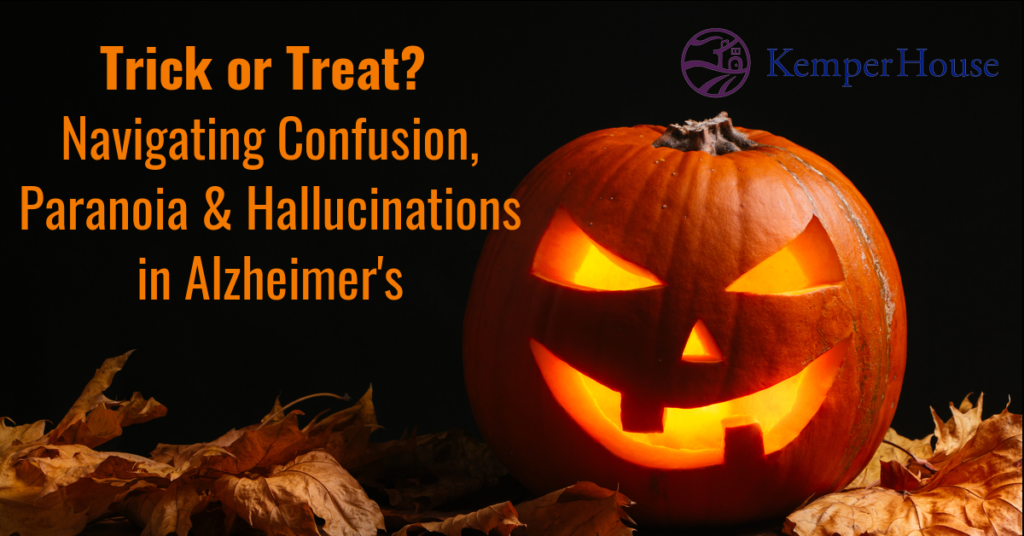
Trick or Treat? Navigating Confusion, Paranoia & Hallucinations in Alzheimer’s
As a caregiver for a loved one, it can be extremely worrying to experience the behavior problems associated with mid-stage Alzheimer’s disease, such as wandering, aggressiveness, hallucinations, or sleeping and eating difficulties.
Challenging behaviors typically manifest out of feelings of anxiety or frustration and are one way the person with memory loss attempts communication with others. The person’s ability to communicate verbally declines as the disease progresses, but one is still emotionally conscious and can remain so, often until the end of life.
Oftentimes, behavior problems are aggravated by environmental stimuli or an inability to deal with stress. But these challenges are not insurmountable. In this article, we’ll look at ways Kemper House tries to handle these “tricky” situations and provide tips for you to manage them as well. We can’t guarantee a “treat” during every visit, but we can certainly be prepared!
Identify the cause of the behavior. How do we respond when an unforeseen environmental stressor leaves a resident confused or an unknown instigator results in paranoia or hallucinations?
Put yourself in the other person’s shoes and don your investigator’s hat. Notice their body language, imagine what they might be trying to express. Did something occur just prior that could be triggering the behavior? Does your response soothe the other person or make the situation worse?
Create a calm, soothing environment. Kemper House is thoughtfully designed to minimize environmental stressors. Lighting is purposely designed to minimize shadows. Flooring is selected carefully with minimal contrast in design and ease of transition in mind. Memory loss combined with deteriorating vision (a problem for many of us as we age) sometimes results in confusion and hallucinations, things we try to manage with environment.
We strive for a calm and soothing environment at Kemper House, but sometimes a small group activity or visiting entertainer can be agitating to a few. Relocating to a quieter place within the building, like the resident’s room or the family room, might be all that’s needed. Also, remember your role in contributing to a calm and soothing environment. Try not to get anxious or upset; respond to the emotion being communicated by the behavior, but not the behavior itself. Check your body language too; the other person is responding to your tone of voice and other non-verbal communication more than the content of what you are saying.
Maintain a consistent schedule. Brain disease often disrupts the sleep-wake cycle. Individuals with Alzheimer’s or other memory loss sometimes experience wakefulness, disorientation, and confusion beginning at dusk. Known as “sundowning,” Kemper House works to manage nighttime restlessness with increased activity during the day, managing daytime napping, and a regular bedtime routine.
Manage stress. Stress-reducing techniques work for some better than others. Light exercise including independent walking, or group exercise – even singing and dancing – can relieve stress. Calming music is another stress-management technique. Activities reminiscent to an earlier time can also be calming: sitting on the front porch, or tending to the courtyard garden for example. While social interaction remains important, large group settings or unfamiliar faces may add to anxiety. Small group settings and one-on-one visits from family or friends may be just what the doctor ordered.
Manage hallucinations and suspicion. Hallucinations are sometimes the result of failing senses, as noted above. It is not helpful to argue with the person about what is real and what is fantasy. Remember, while your family member’s sense of reality may be different than your own, it’s still very real to them. One helpful response is to address the feelings relative to what is being imagined; respond to the emotional content rather than factual/fictional content. When behavioral interventions are ineffective, Kemper House can engage the help of the resident’s physician; medications are sometimes helpful in reducing hallucinations.
Suspicious behavior is not uncommon with a diagnosis of Alzheimer’s or other dementia; memory loss combined with confusion generally leads to suspicion. Individuals often have suspicion of those closest to them: facility caregivers or family members are often targets of suspicion of theft, betrayal, or other improper behavior. The easiest way to manage suspicion is to offer a simple answer to the accusations. Arguing or trying to convince the person their suspicions are unfounded are exercises in futility.
Emotions, perceptions, expectations, and frustrations remain, and the need to express oneself is still present; however, the vehicles once relied upon to do so have deteriorated.
“Trick or Treat?” The person with Alzheimer’s is not trying to “trick” you, and it’s certainly not a “treat” to be on the receiving end of these challenging behaviors. Use this knowledge and arm yourself with some of the tools outlined here to effectively navigate some of the challenges of dementia and Alzheimer’s.
-Jenny Kemper


